|
1977 - A sad loss and big changes
This was a sad but important year for the Aerodrome. The founder, Myles Bickerton FRCS, a ground breaking eye surgeon and one of only a handful of serviceman to serve in all three services in wartime, died on 13 March from cancer. His legacy, the aerodrome, continued under the care and management of his family and staff, in spite of death duties.
It was also a remarkable year of hope for the future. At grass aerodromes aircraft had generally been free to line-up facing into wind and take-off. The CAA decided that the ends and sides of strips as well as runways should be marked. Some aerodromes with flat open approaches were able to have several parallel runways but this was not possible at Denham due to many surrounding trees. Use became concentrated into small areas causing the grass to wear out. As Denham lies over gravel the soil blew away and loose stone came to the surface.
| 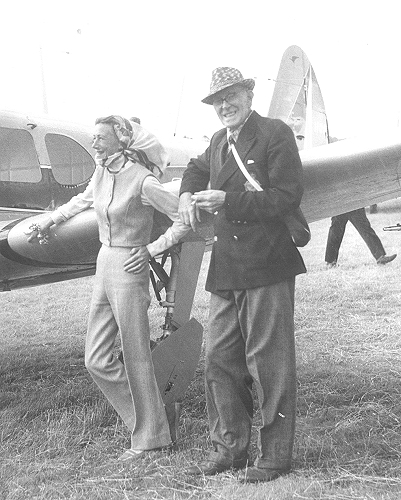
Myles Bickerton FRCS, seen in happier times with Lady Douglas of Kirtleside and Harry Elkin's Me.209.
|
One of the most forward-thinking businessmen in the country, Sir Hector Laing, chairman of United Biscuits had been keeping an aircraft at Denham since 1958. With the expansion of the company, having its own aircraft was ideal for travel not only to the head office in Edinburgh but to new companies in much of Europe. In 1975 the company had upgraded its aircraft to a Super King Air 200, G-BCUZ. The new aircraft with its 1,980 nautical mile range and maximum speed of 333 knots was exactly what the enlarged group needed to communicate effectively. Technical problems with this aircraft meant that it was replaced by G-HLUB in 1977 but this valuable aircraft deserved something better than stones for landing and taking-off.
Before the new aircraft arrived, the company proposed a hard runway as being more suitable for it. A planning application was approved and construction began. The tarmac strip was built over the existing grass runway 07/25. It included edge and end lights and later Precision Approach Path Indicators or PAPI were added. The engineer in charge of the project was Donald Butler who was to have a large influence on other future building work at the aerodrome. Below are a series of pictures that tell the story of its progress.
|
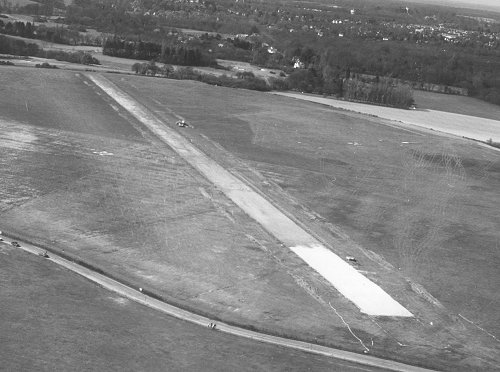
The new hardened runway at Denham began construction in January and followed the line of the existing 07/25 grass runway.
|
|
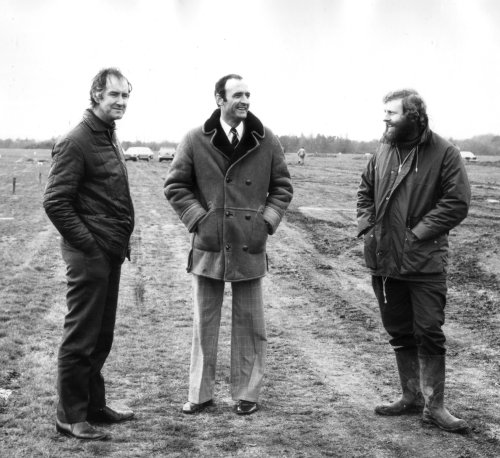
Three of the builders of the new runway, Mr Lewis of Midas Construction who built the runway, Mr Hughes of Genet Plant Hire who supplied the heavy equipment and Mr Fearn of Donald Butler Consulting who were the engineers behind the project.
|
|
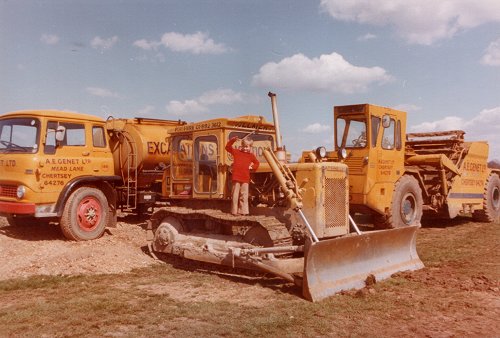
Some of the heavy plant used in the construction of the new runway is inspected by Thomas Paul.
|
|
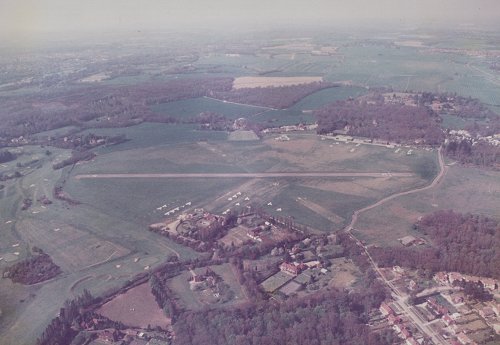
The completed hard runway photographed in August 1977.
|
|
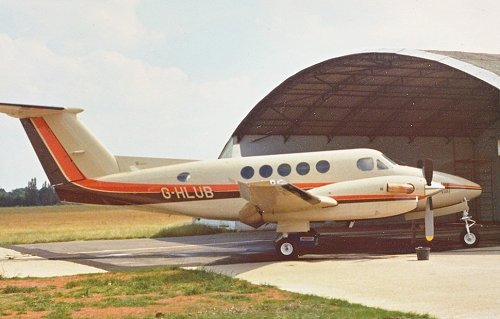
Beechcraft King Air Super 200 G-HLUB outside the blister hangar at Denham.
|
|
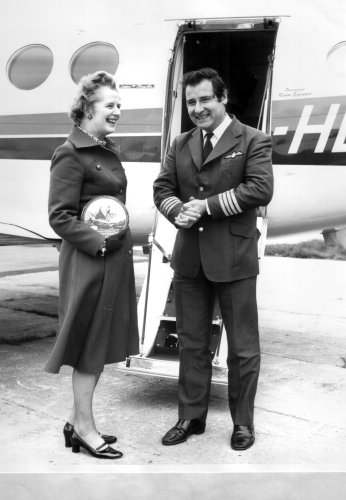
One of the visitors to Denham in 1977 was Margaret Thatcher, then leader of the Conservative Party in opposition. She is seen here with Captain David Ward, chief pilot for United Biscuits.
|
Due to the cost of flying and the difficulty of hiring an aeroplane to take away for several days, some pilots liked to get together to share one of their own. At Denham these groups were restricted to five members so that they did not become unwieldy or take too much business from the flying school. However there were a number of aeroplanes at Denham that were owned by special groups of pilots. Already mentioned in 1955 was the Spartan Group, so named as they started with a Spartan Arrow G-ABWP and the Lapwing Flying Club with Beagle Terrier, G-ASAD. Also resident was the Civil Aviation Authority Flying Association who were all staff or relations of people working at Heathrow. The Metropolitan Police Flying Club came in 1971 bringing Cessna 150 G-AVIA and later acquired a Cessna 172. Relative newcomers were the Aerial Flying Club for employees of the BBC. The Chief Flying Instructor for Aerial was John O'Hara, the BBC's Head of Special Effects, while the Treasurer of the club was Eric Walmsley, an award winning production designer who lived locally in Seer Green. They had purchased a SOCATA Rallye 100ST, G-BCXB and flew it regularly, so it was not unusual to see famous names from the world of television and radio at the aerodrome. The club were to bring a famous BBC children's programme to the airfield in 1993, of which more later.
|
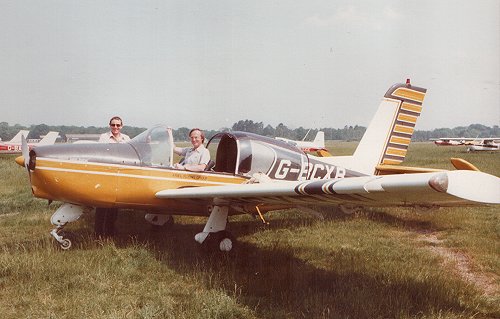
The BBC's Flying Club was called the Aerial Flying Group. Here, Eric Walmsley is seated in the group's SOCATA Rallye 100ST, G-BCXB.
|
Given the success of the earlier Air Displays at Denham Aerodrome, two old freinds of Denham returned on 19 June 1977 in the shape of the Guild of Air Pilots and Air Navigators and the Bentley Driver's Club. The Guild put on a varied event, including a Concours D'Elegance competition for the Bentleys, John Wilkinson in a Denham Flying Training School Cessna 150 Aerobat showing just how manoeuvrable an aircraft it is, a parachute and a hot air balloon display. The programme is reproduced below, and contains a fine tribute to Myles Bickerton, who had been a long time friend and member of the guild.
|
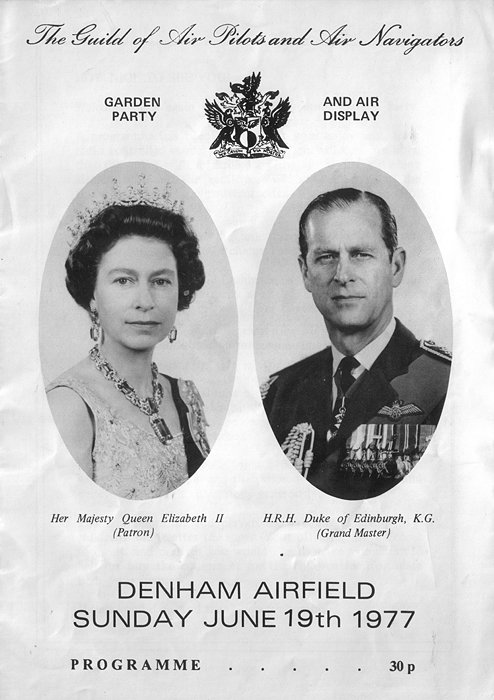
The programme for the 1977 GAPAN Garden Party and Air Display.
|
|
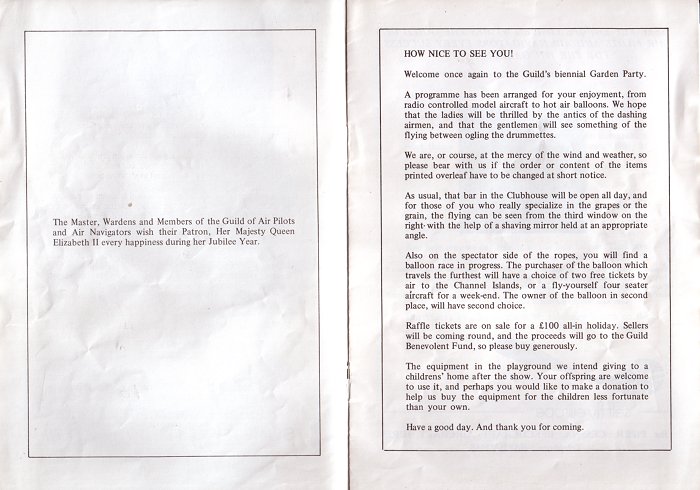
The programme for the 1977 GAPAN Garden Party and Air Display.
|
|
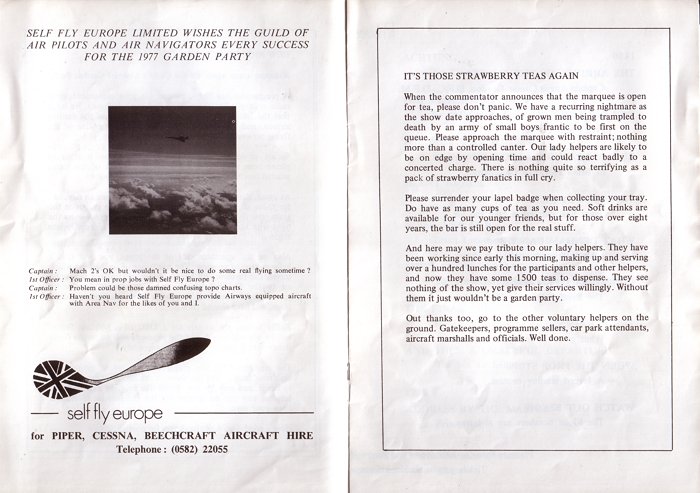
The programme for the 1977 GAPAN Garden Party and Air Display.
|
|
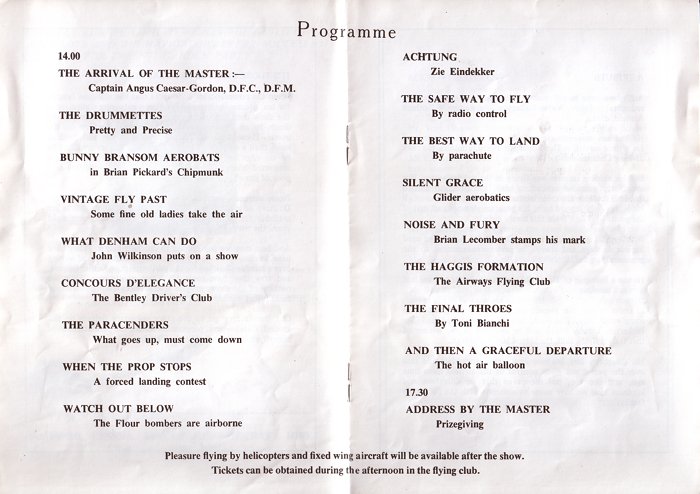
The programme for the 1977 GAPAN Garden Party and Air Display.
|
|
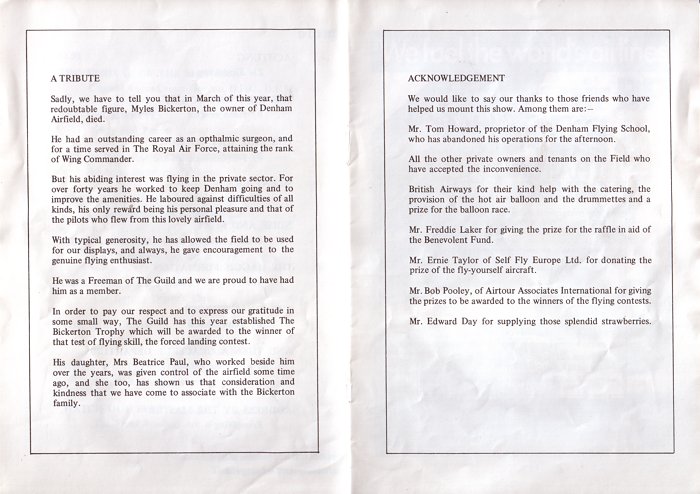
The programme for the 1977 GAPAN Garden Party and Air Display.
|
|
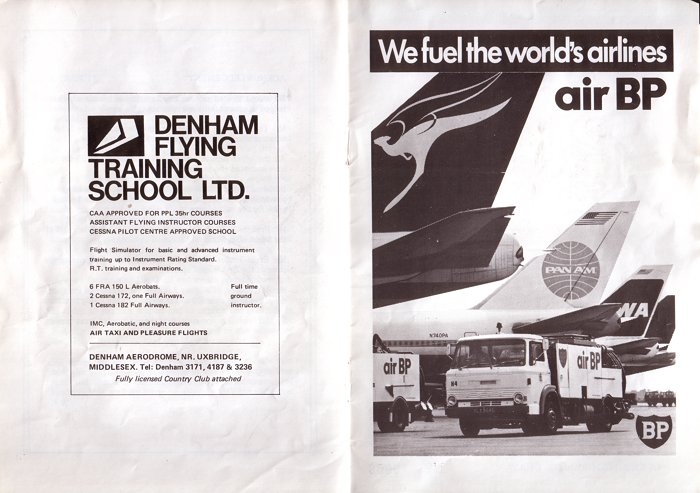
The programme for the 1977 GAPAN Garden Party and Air Display.
|
|
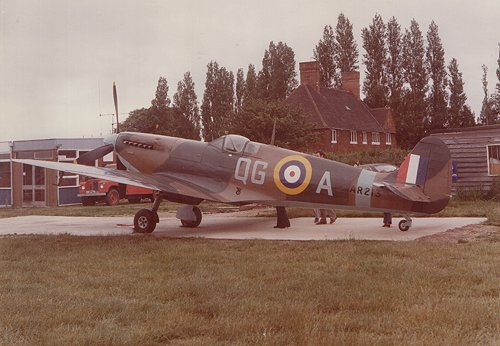
One of the visitors to the GAPAN display was Duxford based Supermarine Spitfire Mk 1a AR213.
|
|
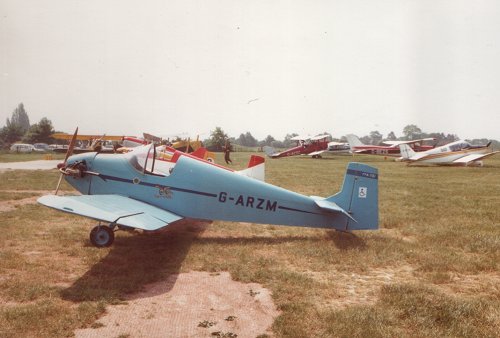
The Tiger Club again supported the GAPAN display with their de Havilland dH.82a Tiger Moths, Stampe SV.4s and Druine Turbulents flying formation and aerobatic displays.
|
|
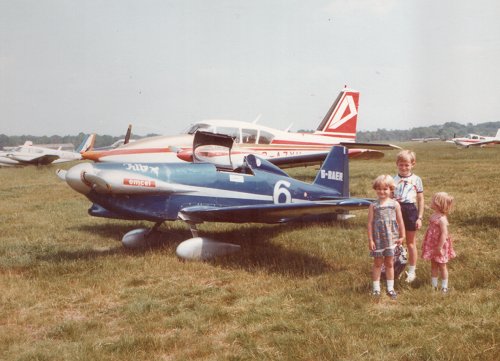
A rare visitor was G-BAER, a Cosmic Wind Formula 1 racer built and owned by Robin Voice, here being inspected by Thomas, Amy and Eva Paul.
|
|
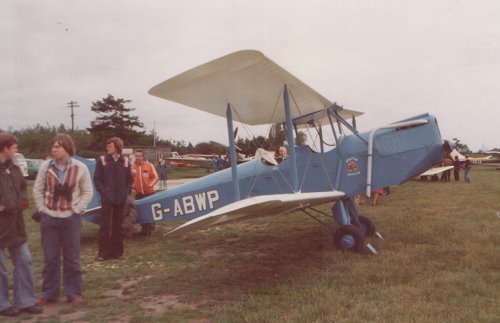
An old friend returned in the shape of G-ABWP, the Spartan Arrow that founded the Spartan Flying Group that is still based at the aerodrome today.
|
|
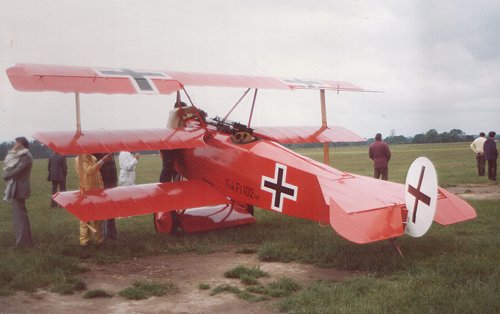
Tony Bianchi's Personal Plane Services brought this Fokker Dr.1 Triplane replica to the show.
|
|
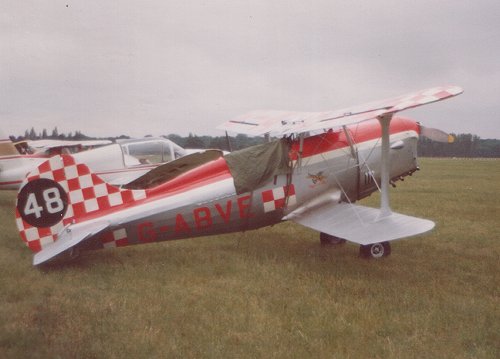
The rarest aircraft at the show was the only Arrow Active Mk II ever built, G-ABVE. Constructed in 1932, this was intended as a racing aircraft with a 120hp de Havilland Gipsy III engine.
|
The Master of the Guild of Air Pilots and Air Navigators in 1977 was Air Commodore Sir Peter Beckford Rutgers Vanneck, who had served as a fighter pilot in the RAF and had previously been and Alderman and later the Sheriff of London. In 1976 he had been elected as the Master of GAPAN, and the following year he became the 650th Lord Mayor of London, a role in which he was to excel. To celebrate this achievement, the members of GAPAN designed and built his float for the Lord Mayor's parade, using the hangars at Denham as the ideal construction space.
|
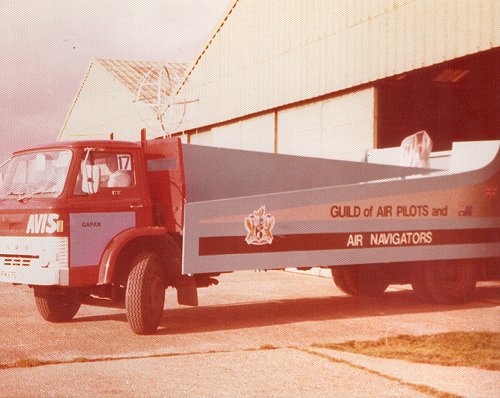
The new Lord Mayor of London's float was built in the hangars at Denham.
|
Denham based aerobatic pilot and author Brian Lecomber had a string of aerobatic successes in 1977. He won the Mc Aully Trophy, the Don Henry Aerobatic Trophy and took first prize in the ICI Aerobatic Championship. Finally, on 20 October, he won the Esso Tiger Challenge Trophy, held at Rochester that year, flying a de Havilland DHC-1 Chipmunk. His first and second novels had been produced in both hard and paper back and his third, 'Talk Down', would be published in the spring.
|
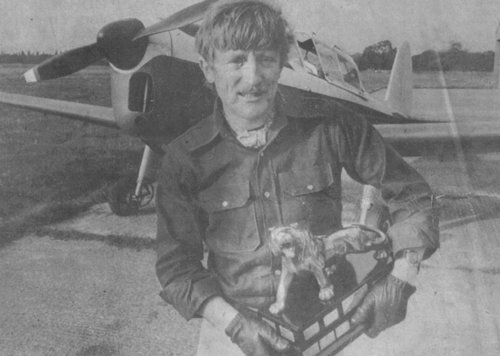
Brian Lecomber holding the Esso Tiger Challenge Trophy in front of the Chipmunk he flew to win it, his fourth aerobatic trophy of 1977.
|
1977 was a year of sweeping and dramatic change at Denham, but more was to come before the decade was out, as will be related next.
|
|

